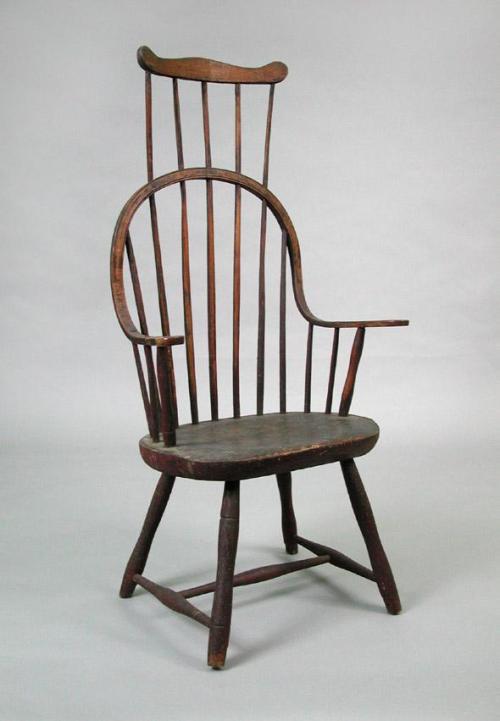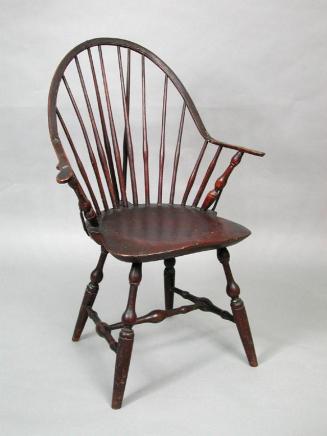Armchair
Furniture MakerMade by
Unknown
Date1795-1810
MediumButternut, maple, oak
DimensionsPrimary Dimensions (overall height x width x depth): 44 1/2 x 22 7/8 x 16 7/8in. (113 x 58.1 x 42.9cm)
ClassificationsFurniture
Credit LineConnecticut Museum of Culture and History collection
Object number2006.28.0
DescriptionRed, painted armchair in the Windsor style, with an extension top, a continuous bow-back, a plank seat, and bamboo-turned legs. The back of the chair consists of an extension top, or crest rail atop five spindles, and a bow, or wooden stick, that is bent in an arch that sweeps forward at each side to form an arm and flat scrolled handhold. The top edge of the serpentine crest rail is shaped with an arch in the center flanked by a flat scroll. The front of the bow is flat with a beaded edge. The arms are tilted up, and each handhold consists of a flat scroll with a stepped profile at the side. The bow is supported by seven spindles of varying height flanked by two shorter spindles and a three-part bamboo-turned post at either side; five of the seven center spindles extend up to form the extension top. The back of the chair is almost straight; the spindles and posts are joined to the seat in a semi-circular arrangement. The butternut plank seat is oval and has a saddled seat, or a contoured upper surface with a raised ridge at the front center, with a flat surface at the back where the spindles and posts join the seat. The sides and back of the plank are curved and chamfered, or cut at an angle. Below the seat are four turned legs that are raked, or slanted out from top to bottom; each is turned with a three-part bamboo form. Each side of the chair has a single stretcher with an ovoid form in the center. Between the stretcher is a single medial stretcher, also with an ovoid form in the center.
Condition: The joints where the legs join the seat are loose. Each foot has a red-painted lap joint and an empty hole. At one time, the armchair was converted to a rocking chair; the rockers have since been removed. The paint on the seat and front legs is well worn and scratched. The armchair has later red paint applied over earlier black and green paint. The red paint has worn off of the crest rail, portions of the spindles, bow, and seat. The red paint is flaking off of the sides of the seat and legs, revealing the green paint.
Design and Construction Details: The crest rail is supported on a tenon at the top of each of the five spindles that extends through the bow; the joint where each side and the center extension spindle meets the bow and the crest rail is nailed. The extension spindles are flanked by a single tall spindle that is tenoned into the bow, and by two short spindles and a post that are tenoned through the arms. The tenon at the top of each post is reinforced with a small wooden wedge through the end of the tenon. The spindle platform is outlined with a narrow groove. The spindles are tenoned down into the spindle platform. The posts are tenoned down through the plank seat. The seat is constructed of a solid plank of wood and is supported on a tenon at the top of each leg. The side stretchers are tenoned into the lower legs. The medial stretcher is tenoned into the side stretchers. The tenons are inserted at an angle, where necessary, to give the proper slant to the bow and each of the spindles and legs.
Condition: The joints where the legs join the seat are loose. Each foot has a red-painted lap joint and an empty hole. At one time, the armchair was converted to a rocking chair; the rockers have since been removed. The paint on the seat and front legs is well worn and scratched. The armchair has later red paint applied over earlier black and green paint. The red paint has worn off of the crest rail, portions of the spindles, bow, and seat. The red paint is flaking off of the sides of the seat and legs, revealing the green paint.
Design and Construction Details: The crest rail is supported on a tenon at the top of each of the five spindles that extends through the bow; the joint where each side and the center extension spindle meets the bow and the crest rail is nailed. The extension spindles are flanked by a single tall spindle that is tenoned into the bow, and by two short spindles and a post that are tenoned through the arms. The tenon at the top of each post is reinforced with a small wooden wedge through the end of the tenon. The spindle platform is outlined with a narrow groove. The spindles are tenoned down into the spindle platform. The posts are tenoned down through the plank seat. The seat is constructed of a solid plank of wood and is supported on a tenon at the top of each leg. The side stretchers are tenoned into the lower legs. The medial stretcher is tenoned into the side stretchers. The tenons are inserted at an angle, where necessary, to give the proper slant to the bow and each of the spindles and legs.
Status
Not on view











